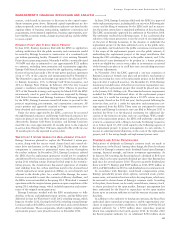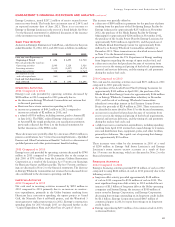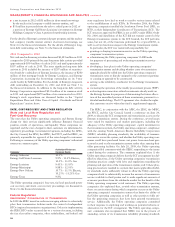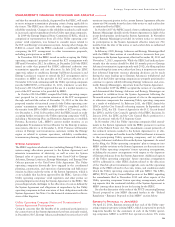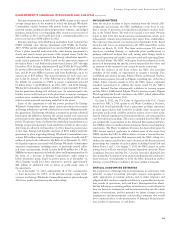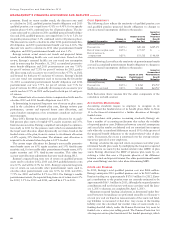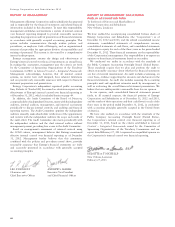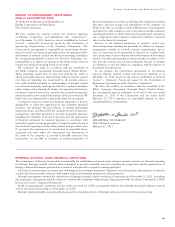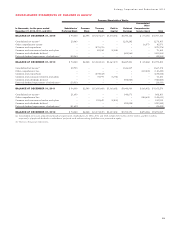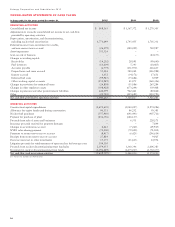Entergy 2012 Annual Report Download - page 47
Download and view the complete annual report
Please find page 47 of the 2012 Entergy annual report below. You can navigate through the pages in the report by either clicking on the pages listed below, or by using the keyword search tool below to find specific information within the annual report.Entergy Corporation and Subsidiaries 2012
MANAGEMENT’S FINANCIAL DISCUSSION AND ANALYSIS continued
that month. Therefore, revenue recognized may be affected by the
estimated price and usage at the beginning and end of each period, in
addition to changes in certain components of the calculation.
Impairment of Long-Lived Assets and
Trust Fund Investments
Entergy has significant investments in long-lived assets in all of its seg-
ments, and Entergy evaluates these assets against the market econom-
ics and under the accounting rules for impairment whenever there
are indications that impairments may exist. This evaluation involves
a significant degree of estimation and uncertainty. In the Entergy
Wholesale Commodities business, Entergy’s investments in merchant
nuclear generation assets are subject to impairment if adverse market
conditions arise, if a unit plans to cease, or ceases, operation sooner
than expected, or for certain units if their operating licenses are not
renewed. Entergy’s investments in merchant non-nuclear generation
assets are subject to impairment if adverse market conditions arise
or if a unit plans to cease, or ceases, operation sooner than expected.
In order to determine if Entergy should recognize an impairment
of a long-lived asset that is to be held and used, accounting standards
require that the sum of the expected undiscounted future cash flows
from the asset be compared to the asset’s carrying value. The carrying
value of the asset includes any capitalized asset retirement cost asso-
ciated with the recording of an additional decommissioning liability,
therefore changes in assumptions that affect the decommissioning lia-
bility can increase or decrease the carrying value of the asset subject
to impairment. If the expected undiscounted future cash flows exceed
the carrying value, no impairment is recorded; if such cash flows are
less than the carrying value, Entergy is required to record an impair-
ment charge to write the asset down to its fair value. If an asset is held
for sale, an impairment is required to be recognized if the fair value
(less costs to sell) of the asset is less than its carrying value.
These estimates are based on a number of key assumptions, including:
n FUTURE POWER AND FUEL PRICES – Electricity and gas prices
have been very volatile in recent years, and this volatility is
expected to continue. This volatility necessarily increases the
imprecision inherent in the long-term forecasts of commodity
prices that are a key determinant of estimated future cash flows.
n MARKET VALUE OF GENERATION ASSETS – Valuing assets held
for sale requires estimating the current market value of generation
assets. While market transactions provide evidence for this valu-
ation, the market for such assets is volatile and the value of indi-
vidual assets is impacted by factors unique to those assets.
n FUTURE OPERATING COSTS – Entergy assumes relatively minor
annual increases in operating costs. Technological or regulatory
changes that have a significant impact on operations could cause a
significant change in these assumptions.
n TIMING – Entergy currently assumes, for a number of its nuclear
units, that the plant’s license will be renewed. A change in that
assumption could have a significant effect on the expected future
cash flows and result in a significant effect on operations.
For additional discussion regarding the continued operation of the
Vermont Yankee plant, see “Impairment of Long-Lived Assets” in
Note 1 to the financial statements.
Entergy evaluates unrealized losses at the end of each period
to determine whether an other-than-temporary impairment has
occurred. The assessment of whether an investment in a debt secu-
rity has suffered an other-than-temporary impairment is based on
whether Entergy has the intent to sell or more likely than not will be
required to sell the debt security before recovery of its amortized costs.
Further, if Entergy does not expect to recover the entire amortized
cost basis of the debt security, an other-than-temporary-impairment
is considered to have occurred and it is measured by the present value
of cash flows expected to be collected less the amortized cost basis
(credit loss). Entergy did not have any material other than temporary
impairments relating to credit losses on debt securities in 2012, 2011,
or 2010. The assessment of whether an investment in an equity secu-
rity has suffered an other than temporary impairment continues to
be based on a number of factors including, first, whether Entergy has
the ability and intent to hold the investment to recover its value, the
duration and severity of any losses, and, then, whether it is expected
that the investment will recover its value within a reasonable period
of time. Entergy’s trusts are managed by third parties who operate
in accordance with agreements that define investment guidelines and
place restrictions on the purchases and sales of investments. As dis-
cussed in Note 1 to the financial statements, unrealized losses that
are not considered temporarily impaired are recorded in earnings for
Entergy Wholesale Commodities. Entergy Wholesale Commodities
did not record material charges to other income in 2012, 2011, and
2010, respectively, resulting from the recognition of the other-than-
temporary impairment of certain equity securities held in its decom-
missioning trust funds. Additional impairments could be recorded in
2013 to the extent that then current market conditions change the
evaluation of recoverability of unrealized losses.
Qualified Pension and Other Postretirement Benefits
Entergy sponsors qualified, defined benefit pension plans which cover
substantially all employees. Additionally, Entergy currently provides
postretirement health care and life insurance benefits for substantially
all employees who reach retirement age and meet certain eligibility
requirements while still working for Entergy. Entergy’s reported costs
of providing these benefits, as described in Note 11 to the financial
statements, are impacted by numerous factors including the provi-
sions of the plans, changing employee demographics, and various
actuarial calculations, assumptions, and accounting mechanisms.
Because of the complexity of these calculations, the long-term nature
of these obligations, and the importance of the assumptions utilized,
Entergy’s estimate of these costs is a critical accounting estimate for
the Utility and Entergy Wholesale Commodities segments.
ASSUMPTIONS
Key actuarial assumptions utilized in determining these costs include:
n Discount rates used in determining future benefit obligations;
n Projected health care cost trend rates;
n Expected long-term rate of return on plan assets;
n Rate of increase in future compensation levels;
n Retirement rates; and
n Mortality rates.
Entergy reviews the first four assumptions listed above on an annual
basis and adjusts them as necessary. The falling interest rate envi-
ronment and volatility in the financial equity markets have impacted
Entergy’s funding and reported costs for these benefits. In addition,
these trends have caused Entergy to make a number of adjustments to
its assumptions.
The retirement and mortality rate assumptions are reviewed every
three to five years as part of an actuarial study that compares these
assumptions to the actual experience of the pension and other post-
retirement plans. The 2011 actuarial study reviewed plan experience
from 2007 through 2010. As a result of the 2011 actuarial study,
changes were made to reflect the expectation that participants have
longer life expectancies and different retirement patterns than previ-
ously assumed. These changes are reflected in the December 31, 2012
and December 31, 2011 financial disclosures.
In selecting an assumed discount rate to calculate benefit obliga-
tions, Entergy reviews market yields on high-quality corporate debt
and matches these rates with Entergy’s projected stream of benefit
45


